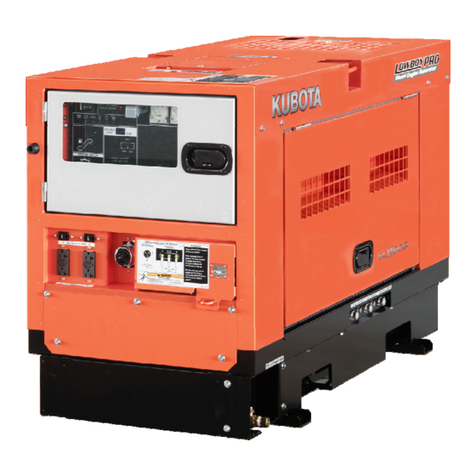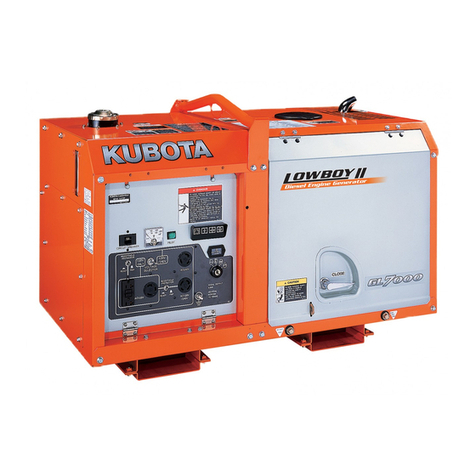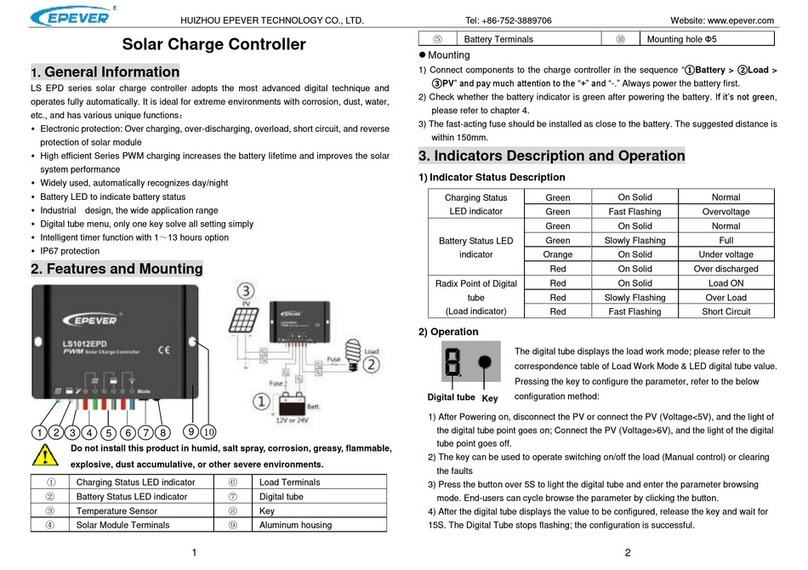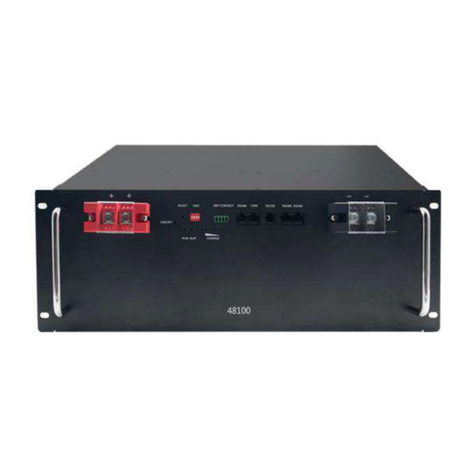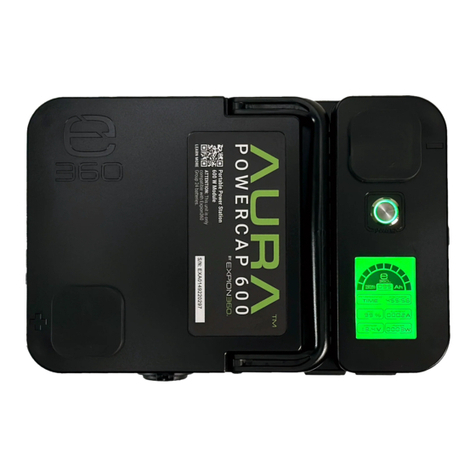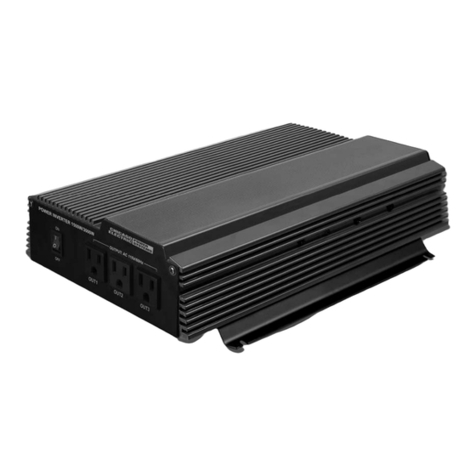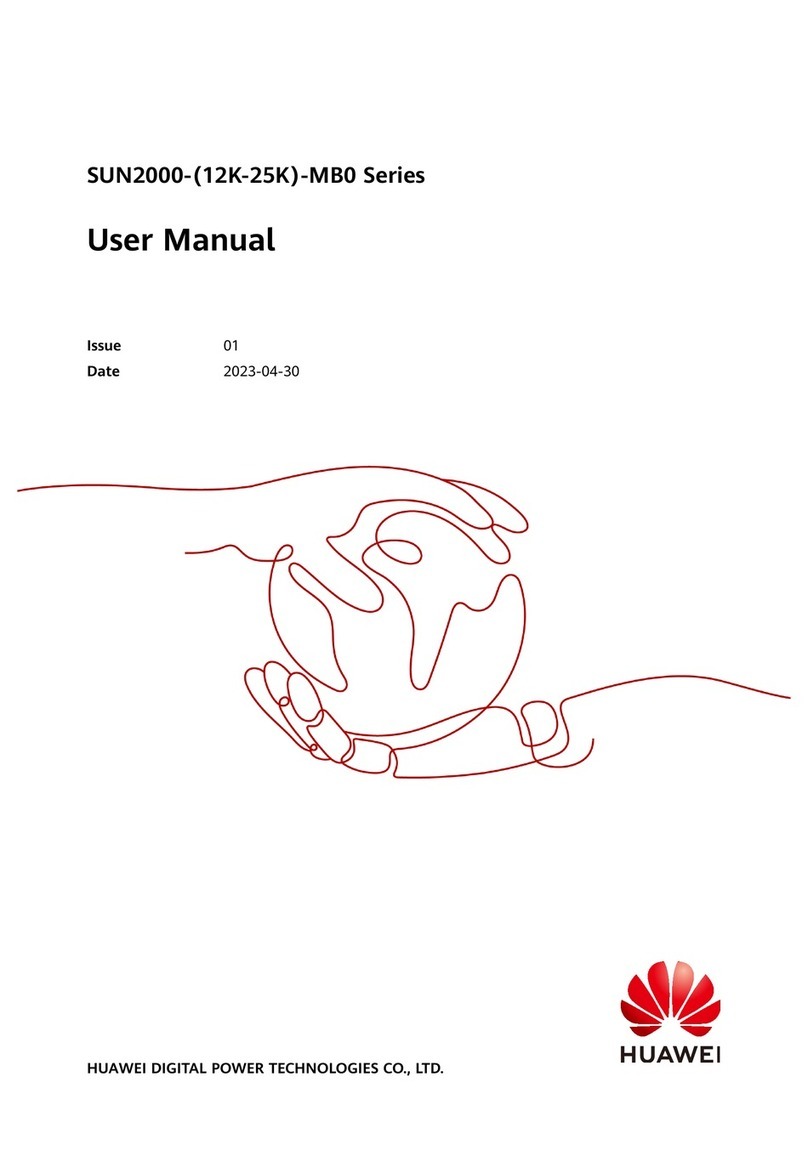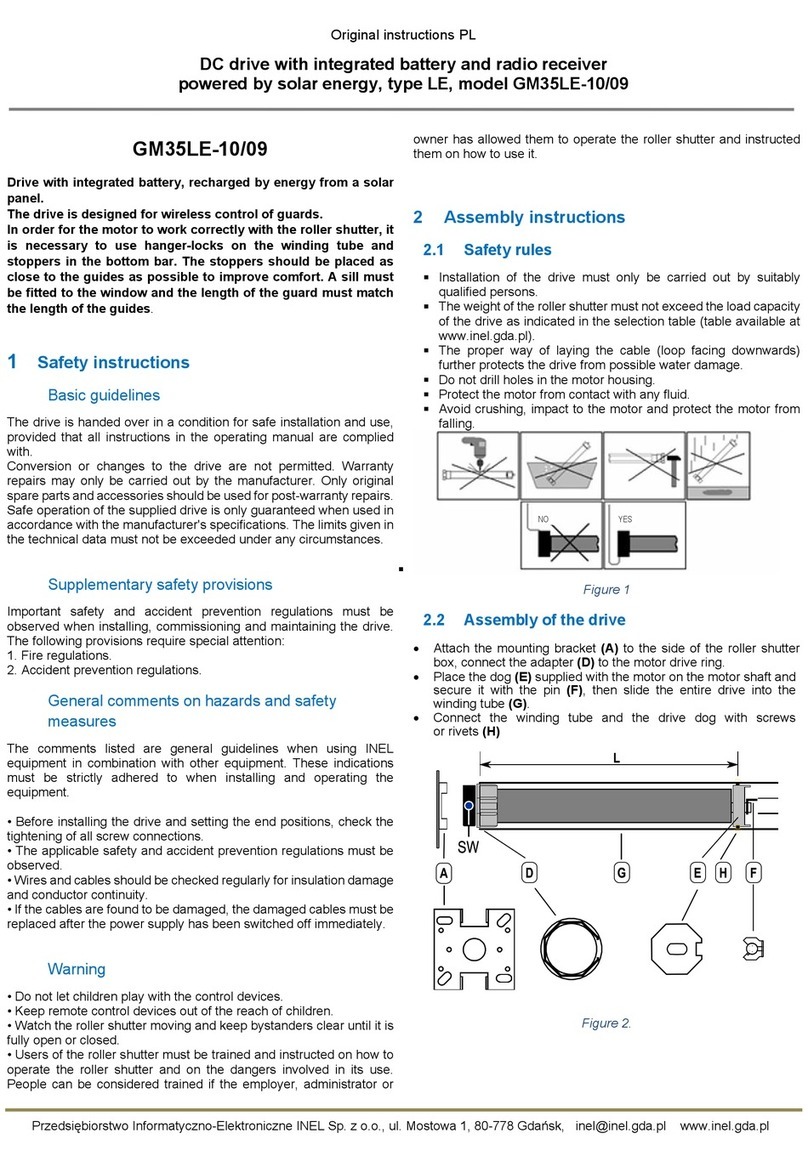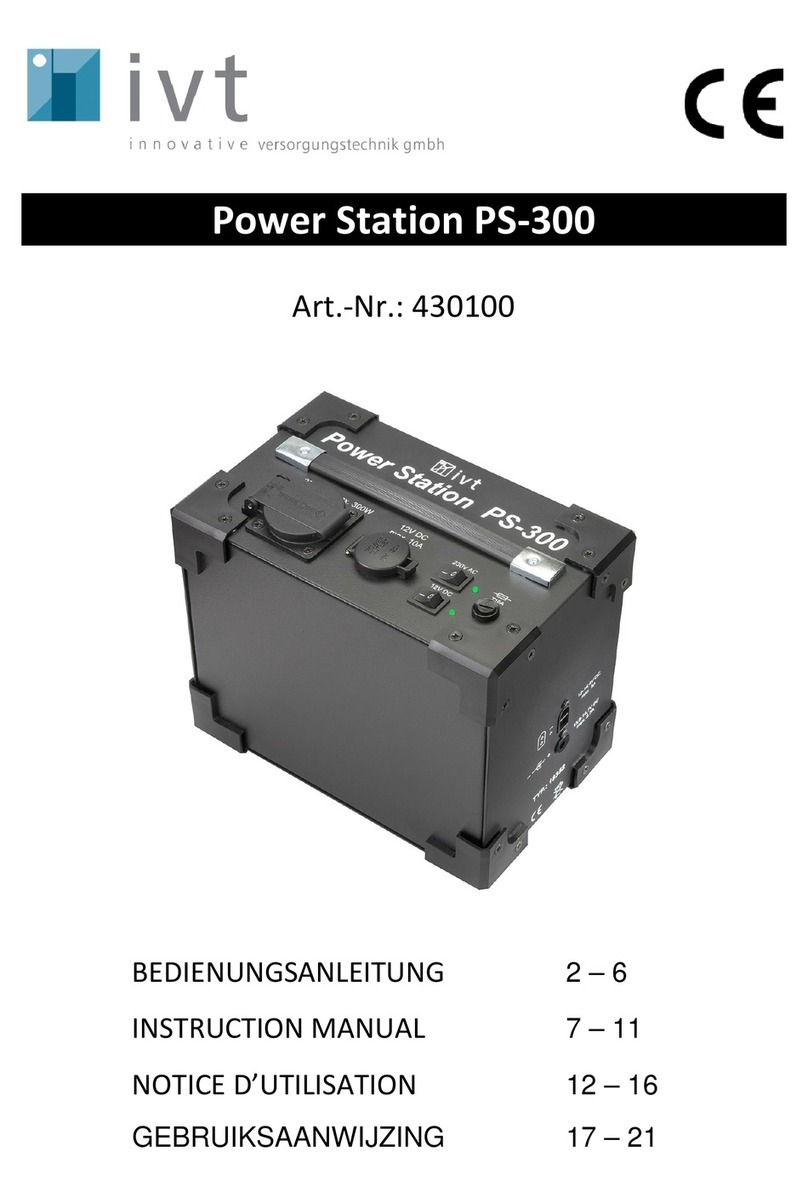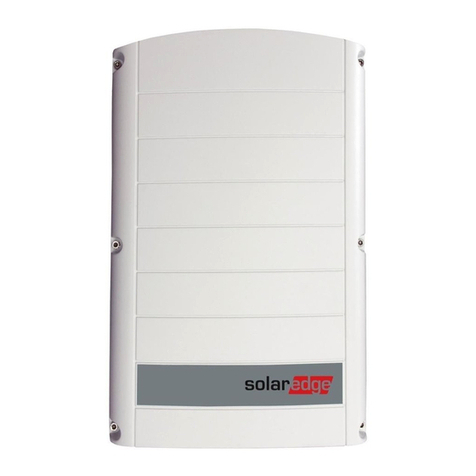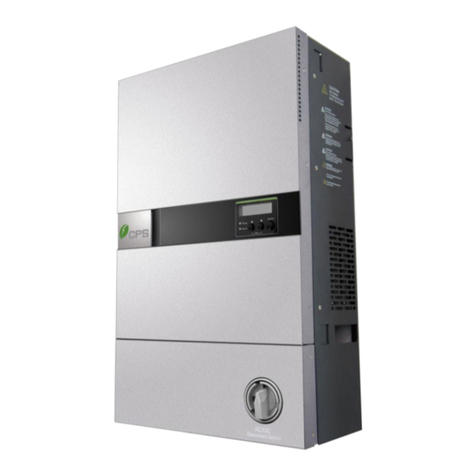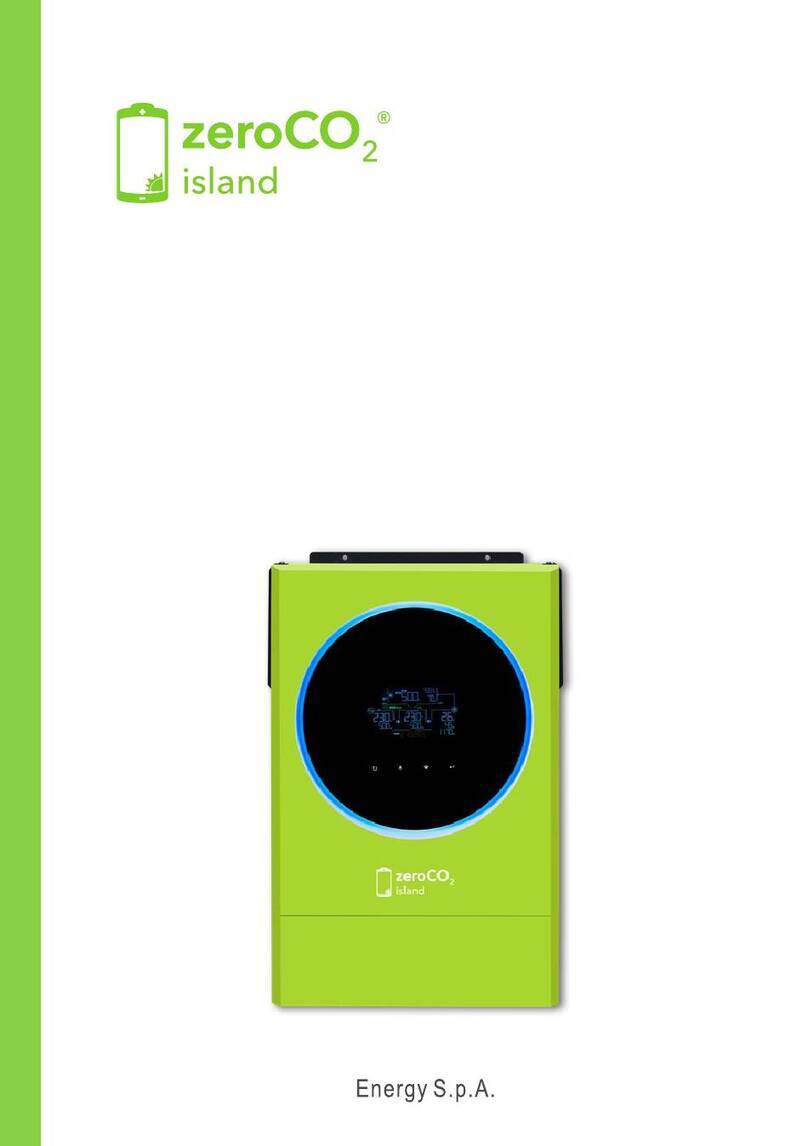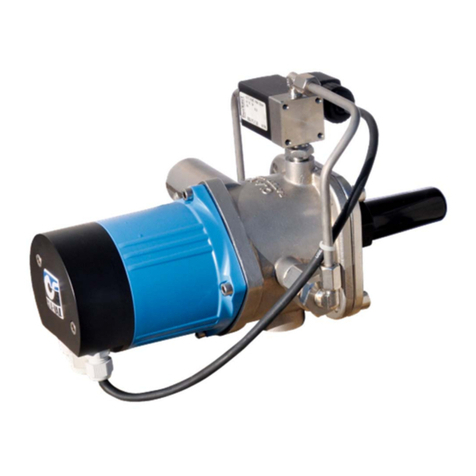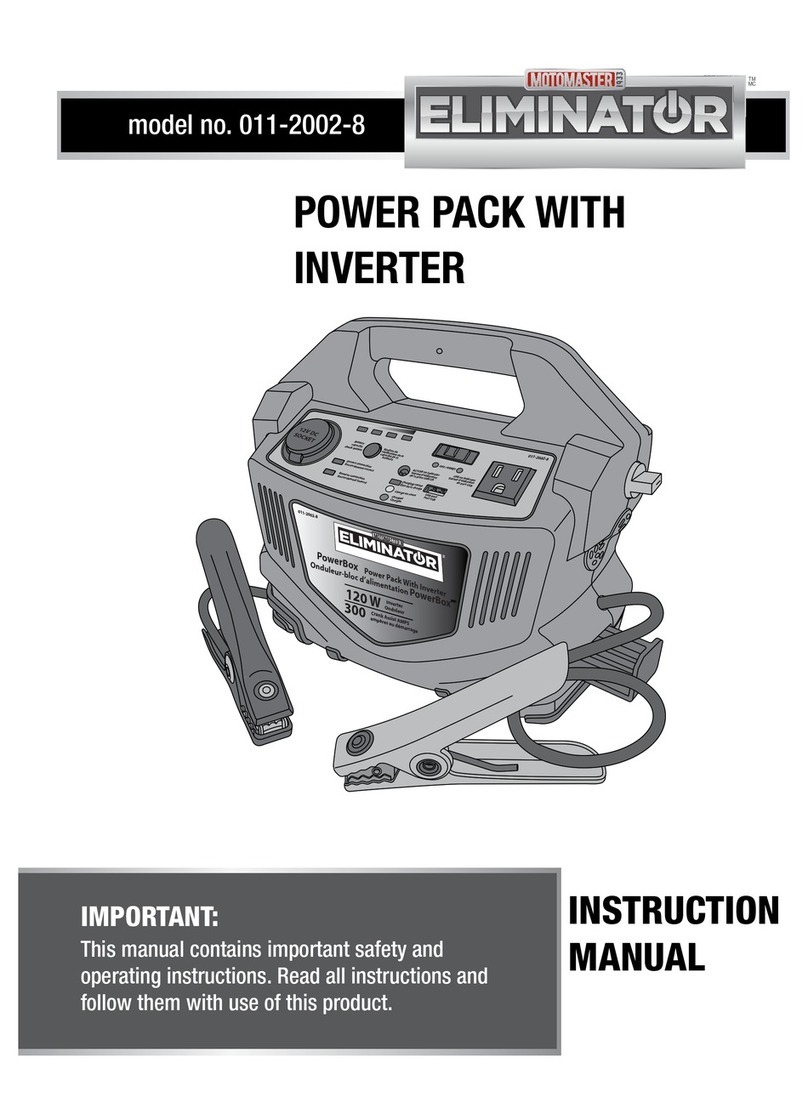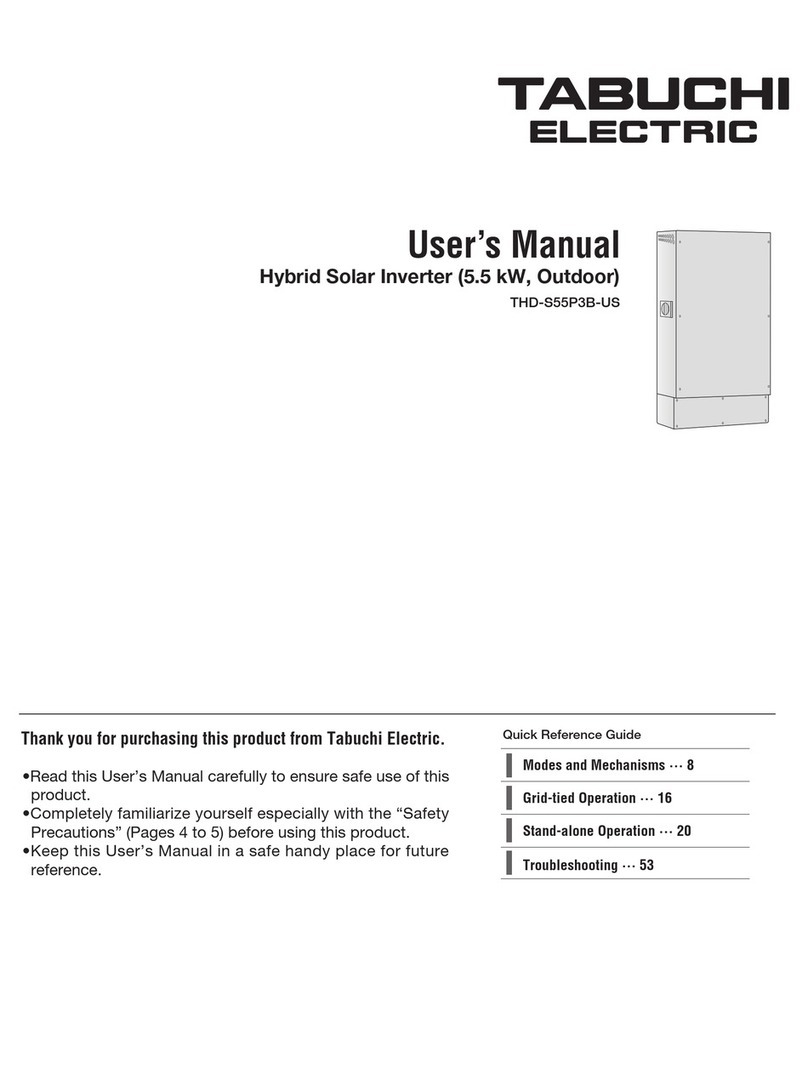Kubota WSM J Series Instruction manual

WORKSHOP MANUAL
DIESEL GENERATOR
J SERIES
KiSC issued 10, 2016 A

TO THE READER
This Workshop Manual has been prepared to provide servicing personnel with
information on the mechanism, service and maintenance of KUBOTA Generator J
Series. It is divided into two parts, “Mechanism” and “Servicing”.
Mechanism
Information on the construction and function are included. This part should be
understood before proceeding with troubleshooting, disassembling and servicing.
Servicing
Under the heading “General” comes general precautions, check and maintenance
and special tools. For each Engine and Generator section, there are troubleshooting,
servicing specification lists, checking and adjusting, disassembling and assembling, and
servicing which cover procedures, precautions, factory specifications and allowable
limits.
All information illustrations and specifications contained in this manual are based on
the latest product information available at the time of publication. The right is reserved
to make changes in all information at any time without notice.
Due to covering many models of this manual, illustration being used, have not been
specified as one model.
October 2000
© KUBOTA Corporation 2000
KiSC issued 10, 2016 A

Record of Revisions
For pdf, use search function {Search word} to find all the revised locations.
Last digit
of the
Code No.
Issue
month Main Revised Point and Corrective Measures {Search word} Reference
Page
52016.10 AVR circuit changed. M-10 to
M-32
KiSC issued 10, 2016 A

1
SAFETY INSTRUCTIONS
J SERIES, WSM
SAFETY INSTRUCTIONS
BEFORE SERVICING AND REPAIRING
• Read all instructions and safety instructions in this
manual and on your generator safety decals.
• Clean the work area and generator.
• Place the generator on a firm and level ground.
• Allow the engine to cool before proceeding.
• Stop the engine, and remove the key.
• Disconnect the battery negative cable.
SAFETY FIRST
This symbol, the industry’s “Safety Alert Symbol”, is used throughout this manual and decals on the
generator itself to warn of the possibility of personal injury. Read these instructions carefully.
It is essential that you read the instructions and safety regulations before you attempt to repair or use
this unit.
DANGER : Indicates an imminently hazardous situation which, if not avoided, will result in
death or serious injury.
WARNING : Indicates a potentially hazardous situation which, if not avoided, could result in
death or serious injury.
CAUTION : Indicates a potentially hazardous situation which, if not avoided, may result in
minor or moderate injury.
IMPORTANT : Indicates that equipment or property damage could result if instructions are not
followed.
NOTE : Gives helpful information.
KiSC issued 10, 2016 A

2
J SERIES, WSM SAFETY INSTRUCTIONS
SAFETY STARTING
• Do not start the engine by shorting across starter
terminals.
• Unauthorized modifications to the engine may impair
the function and / or safety and affect engine life.
SAFETY WORKING
• Do not work on the generator while under the
influence of alcohol, medication, or other substances
or while fatigued.
• Wear close fitting clothing and safety equipment
appropriate to the job.
• Use tools appropriate to the work. Makeshift tools,
parts, and procedures are not recommended.
• When servicing is performed together by two or more
persons, take care to perform all work safely.
• Do not touch the rotating or hot parts while the engine
is running.
• Never remove the radiator cap while the engine is
running, or immediately after stopping. Otherwise, hot
water will spout out from radiator. Only remove
radiator cap when cool enough to touch with bare
hands. Slowly loosen the cap to first stop to relieve
pressure before removing completely.
• Escaping fluid (fuel) under pressure can penetrate the
skin causing serious injury. Relieve pressure before
disconnecting fuel lines. Tighten all connections
before applying pressure.
• Wear a suitable hearing protective device such as
earmuffs or earplugs to protect against objectionable
or uncomfortable loud noises.
AVOID FIRES
• Fuel is extremely flammable and explosive under
certain conditions. Do not smoke or allow flames or
sparks in your working area.
• To avoid sparks from an accidental short circuit,
always disconnect the battery negative cable first and
connect it last.
• Battery gas can explode. Keep sparks and open
flame away from the top of battery, especially when
charging the battery.
• Make sure that no fuel has been spilled on the engine.
KiSC issued 10, 2016 A

3
SAFETY INSTRUCTIONS
J SERIES, WSM
VENTILATE WORK AREA
• If the generator must be running to do some work,
make sure the area is well ventilated. Never run the
engine in a closed area. The exhaust gas contains
poisonous carbon monoxide.
PREVENT ACID BURNS
• Sulfuric acid in battery electrolyte is poisonous. It is
strong enough to burn skin, clothing and cause
blindness if splashed into eyes. Keep electrolyte
away from eyes, hands and clothing. If you spill
electrolyte on yourself, flush with water, and get
medical attention immediately.
DISPOSE OF FLUIDS PROPERLY
• Do not pour fluids into the ground, down a drain, or
into a stream, pond, or lake. Observe relevant
environmental protection regulations when disposing
of oil, fuel, coolant, electrolyte and other harmful
waste.
PREPARE FOR EMERGENCIES
• Keep a first aid kit and fire extinguisher handy at all
times.
• Keep emergency numbers for doctors, ambulance
service, hospital and fire department near your
telephone.
KiSC issued 10, 2016 A

4
J SERIES, WSM SAFETY INSTRUCTIONS
The following safety decals are installed on the generator.
If a decal becomes damaged, illegible or is not on the generator, replace it.
The decal part number is listed in the parts list.
SAFETY DECALS
KiSC issued 10, 2016 A

5
SPECIFICATIONS
J SERIES, WSM
SPECIFICATIONS
[50Hz]
W10275180
Model J106 J108 J112 J116
-STD -AUS -STD -AUS -STD -AUS -STD -AUS
Generator
Type Revolving-field, brush type, separate and self - excitation system, AC generator
Insulation
class Rotor coil: F Stator coil: B
Frequency 50 Hz
Standby
output 6.0 kVA (6.0 kW) 8.8 kVA (8.8 kW) 13.2 kVA (13.2 kW) 17.6 kVA (17.6 kW)
Prime output 5.5 kVA (5.5 kW) 8.0 kVA (8.0 kW) 12 kVA (12 kW) 16 kVA (16 kW)
Voltage 220 V 240 V 220 V 240 V 220 V 240 V 220 V 240 V
Rated
amperage 25.0 A 22.9 A 36.4 A 33.3 A 54.5 A 50.0 A 72.7 A 66.7 A
Number of
phases Single
Number of
poles 2
Power factor 100 %
Engine
Model Z482-B-SEC D722-B-SEC D1005-BG-SEC V1305-BG-SEC
Design Vertical, liquid cooled, 4 cycle, diesel engine
Number of
cylinders 234
Bore x Stroke 67 x 68 mm (2.52 x 2.68 in.) 76 x 73.6 mm (2.99 x 2.90 in.)
Displacement 479 cm3(29.23 cu.in.) 719 cm3(43.89 cu.in.) 1001 cm3(61.08 cu.in.) 1335 cm3(81.46 cu.in.)
Combustion
system Spherical combustion chamber
Compression
ratio 23:1 22:1
Cooling
system Pressurized radiator, forced circulation with water pump
Lubricating
system Forced lubrication by trochoid pump
Lubricating oil Higher than CD class (API)
Starting
system Electric type
Stop solenoid Energized to stop Energized to run
Battery 38B20R 55B24R 80D26R (S)
Fuel tank
capacity
37 L
(9.8 U.S.gals, 8.1 Imp. gals.)
79 L
(20.9 U.S. gals, 17.4 Imp. gals.)
Cooling
system
capacity
2.3 L
(2.4U.S.qts.,2.0 Imp.qts.)
3.0L
(3.2U.S.qts.,2.6 Imp.qts.)
3.3 L
(3.5U.S.qts.,2.9 Imp.qts.)
3.5 L
(3.7U.S.qts.,3.1 Imp.qts.)
Crankcase oil
capacity
2.2 L
(2.3U.S.qts.,2.0 Imp.qts.)
3.4 L
(3.6U.S.qts.,3.0 Imp.qts.)
4.3 L
(4.6U.S.qts.,3.8 Imp.qts.)
5.7 L
(6.0U.S.qts.,5.0 Imp.qts.)
Continuous operating
hours (at 3/4 load) 19.0 Hr 13.5 Hr 20.0 Hr 16.5 Hr
Net weight 225 kg (496 lbs) 255 kg (562 lbs) 340 kg (750 lbs) 380 kg (838 lbs)
Emergency stop
mechanism
During engine operation, automatic shutdown will
occur when either the oil pressure or the water
temperature is abnormal.
During engine operation, automatic shutdown will
occur when either the oil pressure or the water
temperature is abnormal or when the fan belt breaks.
With Caster Option None
KiSC issued 10, 2016 A

6
J SERIES, WSM SPECIFICATIONS
W10308040
Model J310 J315 J320
-STD -AUS -STD -AUS -STD -AUS
Generator
Type Revolving-field, brush type, separate and self - excitation system, AC generator
Insulation
class Rotor coil: F Stator coil: B
Frequency 50 Hz
Standby
output 11 kVA (8.8 kW) 16.5 kVA (13.2 kW) 22 kVA (17.6 kW)
Prime output 10 kVA (8 kW) 6 kVA
(6 kW) 15 kVA (12 kW) 9 kVA
(9 kW) 20 kVA (16 kW) 10.8 kVA
(10.8 kW)
Voltage 380 V 415 V 240 V 380 V 415 V 240 V 380 V 415 V 240 V
Rated
amperage 15.2 A 13.9 A 8.3 x 3 A 22.8 A 20.9 A 12.5 x 3 A 30.4 A 27.8 A 15 x 3 A
Number of
phases Three
Number of
poles 2
Power factor 80 % 100 % 80 % 100 % 80 % 100 %
Engine
Model D722-B-SEC D1005-BG-SEC V1305-BG-SEC
Design Vertical, liquid cooled, 4 cycle, diesel engine
Number of
cylinders 34
Bore x Stroke 67 x 68 mm (2.52 x 2.68 in.) 76 x 73.6 mm (2.99 x 2.90 in.)
Displacement 719 cm3(43.89 cu.in.) 1001 cm3(61.08 cu.in.) 1335 cm3(81.46 cu.in.)
Combustion
system Spherical combustion chamber
Compression
ratio 23:1 22:1
Cooling
system Pressurized radiator, forced circulation with water pump
Lubricating
system Forced lubrication by trochoid pump
Lubricating oil Higher than CD class (API)
Starting
system Electric type
Stop solenoid Energized to stop Energized to run
Battery 55B24R 80D26R (S)
Fuel tank
capacity
37 L
(9.8U.S.gals., 8.1 Imp. gals.)
79 L
(20.9U.S.gals., 17.4 Imp.gals.)
Cooling
system
capacity
3.0 L
(3.2U.S.qts., 2.6 Imp.qts.)
3.3 L
(3.5U.S.qts., 2.9 Imp.qts.)
3.5 L
(3.7U.S.qts., 3.1 Imp.qts.)
Crankcase oil
capacity
3.4 L
(3.6U.S.qts., 3.0 Imp.qts.)
4.3 L
(4.6U.S.qts., 3.8 Imp.qts.)
5.7 L
(6.0U.S.qts., 5.0 Imp.qts.)
Continuous operating
hours (at 3/4 load) 13.5 Hr 20.0 Hr 16.5 Hr
Net weight 255 kg (562 lbs) 340 kg (750 lbs) 380 kg (838 lbs)
Emergency stop
mechanism
During engine operation,
automatic shutdown will occur
when either the oil pressure or
the water temperature is
abnormal.
During engine operation, automatic shutdown will occur when either the oil
pressure or the water temperature is abnormal or when the fan belt breaks.
With Caster Option None
KiSC issued 10, 2016 A

7
SPECIFICATIONS
J SERIES, WSM
[60Hz]
W10439640
Model J107 J110 J114 J119
-STD -SA -STD -SA -STD -SA -STD -SA
Generator
Type Revolving-field, brush type, separate and self - excitation system, AC generator
Insulation
class Rotor coil: F Stator coil: B
Frequency 60 Hz
Standby
output 7.1 kVA (7.1 kW) 11.0 kVA (11.0 kW) 15.4 kVA (15.4 kW) 20.6 kVA (20.6 kW)
Prime output
6.5 kVA (6.5 kW) 10 kVA (10 kW) 14 kVA
(14 kW)
11.5 kVA
(11.5 kW) /
14 kVA
(14 kW)
18.8 kVA
(18.8 kW)
11.5 kVA
(11.5 kW) /
18.8 kVA
(18.8 kW)
Voltage 110 / 220V 127 / 220V 110 / 220V 127 / 220V 110 / 220V 127 / 220V 110 / 220V 127 / 220V
Rated
amperage
59.1 /
29.5A
51.2 /
29.5A
90.9 /
45.5A
78.7 /
45.5A
63.6 x 2 /
63.6 A
90.6 /
63.6A
85.5 x 2 /
85.5 A
90.6 /
85.5A
Number of
phases Single
Number of
poles 2
Power factor 100 %
Engine
Model Z482-B-SEC D722-B-SEC D1005-BG-SEC V1305-BG-SEC
Design Vertical, liquid cooled, 4 cycle, diesel engine
Number of
cylinders 234
Bore x Stroke 67 x 68 mm (2.52 x 2.68 in.) 76 x 73.6 mm (2.99 x 2.90 in.)
Displacement 479 cm3(29.23 cu.in.) 719 cm3(43.89 cu.in.) 1001 cm3(61.08 cu.in.) 1335 cm3(81.46 cu.in.)
Combustion
system Spherical combustion chamber
Compression
ratio 23:1 22:1
Cooling
system Pressurized radiator, forced circulation with water pump
Lubricating
system Forced lubrication by trochoid pump
Lubricating oil Higher than CD class (API)
Starting
system Electric type
Stop solenoid Energized to stop Energized to run
Battery 38B20R 55B24R 80D26R (S)
Fuel tank
capacity
37 L
(9.8U.S.gals., 8.1 Imp.gals.)
79 L
(20.9U.S.gals.,17.4 Imp.gals.)
Cooling
system
capacity
2.3 L
(2.4U.S.qts.,2.0 Imp.qts.)
3.0 L
(3.2U.S.qts.,2.6 Imp.qts.)
3.3 L
(3.5U.S.qts.,2.9 Imp.qts.)
3.5 L
(3.7U.S.qts.,3.1 Imp.qts.)
Crankcase oil
capacity
2.2 L
(2.3U.S.qts.,2.0 Imp.qts.)
3.4 L
(3.6U.S.qts.,3.0 Imp,qts.)
4.3 L
(4.6U.S.qts.,3.8 Imp.qts.)
5.7 L
(6.0U.S.qts.,5.0 Imp.qts.)
Continuous operating
hours (at 3/4 load) 15.5 Hr 10.5 Hr 16.0 Hr 13.0 Hr
Net weight 225 kg (496 lbs) 255 kg (562 lbs) 340 kg (750 lbs) 380 kg (838 lbs)
Emergency stop
mechanism
During engine operation, automatic shutdown will
occur when either the oil pressure or the water
temperature is abnormal.
During engine operation, automatic shutdown will
occur when either the oil pressure or the water
temperature is abnormal or when the fan belt breaks.
With Caster Option None
KiSC issued 10, 2016 A

8
J SERIES, WSM SPECIFICATIONS
W10450270
Model J313 J318 J324
-STD -STD -STD
Generator
Type Revolving-field, brush type, separate and self - excitation system, AC generator
Insulation
class Rotor coil: F Stator coil: B
Frequency 60 Hz
Standby
output 13.7 kVA (11 kW) 19.2 kVA (15.4 kW) 25.8 kVA (20.6 kW)
Prime output 12.5 kVA (10 kW) 17.5 kVA (14 kW) 23.5 kVA (18.8 kW)
Voltage 220 V 220 V 220 V
Rated
amperage 32.8 A 45.9 A 61.7 A
Number of
phases Three
Number of
poles 2
Power factor 80 %
Engine
Model D722-B-SEC D1005-BG-SEC V1305-BG-SEC
Design Vertical, liquid cooled, 4 cycle, diesel engine
Number of
cylinders 34
Bore x Stroke 67 x 68 mm (2.52 x 2.68 in.) 76 x 73.6 mm (2.99 x 2.90 in.)
Displacement 719 cm3(43.89 cu.in.) 1001 cm3(61.08 cu.in.) 1335 cm3(81.46 cu.in.)
Combustion
system Spherical combustion chamber
Compression
ratio 23:1 22:1
Cooling
system Pressurized radiator, forced circulation with water pump
Lubricating
system Forced lubrication by trochoid pump
Lubricating oil Higher than CD class (API)
Starting
system Electric type
Stop solenoid Energized to stop Energized to run
Battery 55B24R 80D26R (S)
Fuel tank
capacity
37 L
(9.8U.S.gals., 8.1 Imp.gals.)
79 L
(20.9U.S.gals., 17.4 Imp.gals.)
Cooling
system
capacity
3.0 L
(3.2U.S.qts., 2.6 Imp.qts.)
3.3 L
(3.5U.S.qts., 2.9 Imp.qts.)
3.5 L
(3.7U.S.qts., 3.1 Imp.qts.)
Crankcase oil
capacity
3.4 L
(3.6U.S.qts., 3.0 Imp.qts.)
4.3 L
(4.6U.S.qts., 3.8 Imp.qts.)
5.7 L
(6.0U.S.qts., 5.0 Imp.qts.)
Continuous operating
hours (at 3/4 load) 10.5 Hr 16.0 Hr 13.0 Hr
Net weight 255 kg (562 lbs) 340 kg (750 lbs) 380 kg (838 lbs)
Emergency stop
mechanism
During engine operation, automatic
shutdown will occur when either
the oil pressure or the water
temperature is abnormal.
During engine operation, automatic shutdown will occur when either the
oil pressure or the water temperature is abnormal or when the fan belt
breaks.
With Caster Option None
KiSC issued 10, 2016 A

9
DIMENSIONS
J SERIES, WSM
DIMENSIONS
W1027052
Model J106-STD, -AUS
J107-STD, -SA
J108-STD, -AUS
J110-STD, -SA
J310-STD, -AUS
J313-STD
J112-STD, -AUS
J114-STD, -SA
J315-STD, -AUS
J318-STD
J116-STD, -AUS
J119-STD, -SA
J320-STD, -AUS
J324-STD
Length mm (in.) 923 (36.4) 995 (39.2) 1215 (47.8) 1300 (51.1)
Width mm (in.) 593 (23.3) 593 (23.3) 611 (24.1) 611 (24.1)
Height mm (in.) 860 (33.8) 860 (33.8) 922 (36.3) 922 (36.3)
KiSC issued 10, 2016 A

CONTENTS
MECHANISM
1. GENERATOR .................................................................................................. M-1
[1] STRUCTURE ............................................................................................. M-1
[2] AUTOMATIC VOLTAGE REGULATOR (A.V.R.)..................................... M-2
[3] EMERGENCY RELAY CIRCUIT.............................................................. M-4
(1) General ................................................................................................ M-4
(2) Instructions........................................................................................... M-5
(3) Flow Chart............................................................................................ M-7
[4] EARTH ....................................................................................................... M-9
[5] WIRING DIAGRAM ................................................................................. M-10
KiSC issued 10, 2016 A

M-1
GENERATOR
J SERIES, WSM
1. GENERATOR
[1] STRUCTURE
1. Stator Assembly
The main coil and sub coil for power generation are wound in the slots provided in the core.
The main coil generates the AC output and supplies A.V.R. assembly with a sensing voltage
The sub coil, working as an excitation coil, supplies the field current to the rotor through A.V.R. assembly.
2. Rotor Assembly
The coils are wound to magnetize the entire core.
3. Brush Holder Assembly
The excitation voltage from sub coil of the stator assembly is applied to the rotor coil through the A.V.R. assembly
rectifying circuit and the brush holder assembly.
4. Automatic Voltage Regulator (A.V.R.) Assembly
The A.V.R. assembly maintains the AC output voltage at a constant level.
(1) Rear Cover
(2) A.V.R. Assembly
(3) Brush Holder Assembly
(4) Rear Bracket
(5) Stator Assembly
(6) Stator Housing
(7) Rotor Assembly
(8) Fan
(9) Fan (Z482 only)
KiSC issued 10, 2016 A

M-2
J SERIES, WSM GENERATOR
[2] AUTOMATIC VOLTAGE REGULATOR (A.V.R.)
NOTE
• It is hazardous to proceed to any high voltage test on the alternator without having previously
disconnected all connections to voltage regulator.
Damages occurring to A.V.R. in such conditions will not be considered in a warranty claim.
W1013858
(1) A.V.R.
(2) Capacitor
(3) Silicon Diode Stack
(4) Separate Excitation Unit
KiSC issued 10, 2016 A

M-3
GENERATOR
J SERIES, WSM
The block diagram of J Series A.V.R.’s is shown below. The A.V.R. consists basically of the components detector
(12) through transistor (4). To run it for practical use, the other components separate excitation unit (14) through
battery (16) are combined.
W1017260
(1) Detector
The detector (12) monitors the generator’s output voltage. The generator’s detection coil (13) is connected to this
component.
(2) Controller
The controller (11) is designed to compare the voltage picked up by the detector (12) with the preset reference
voltage and to give a transistor ON and OFF signal to the drive circuit (5). When the output voltage rises too high, it
is made to drop; if it drops too low, it is made to rise.
(3) Photocoupler
The photocoupler (6) sends a control signal to the drive circuit (5). It is internally composed of light emitter (9) and
light receiver (7) to send and receive light signals (8). Because of such wireless transmission, the light emitter circuit
and the light receiver circuit can be electrically insulated from each other (10). On the A.V.R., the drive circuit (5) with
the exciter coil (1) connected and the controller (11) with the detection coil (13) hooked up are insulated as different
blocks on the circuit board. (The printed patterns of these blocks may also be arranged at a physical distance away
from each other.) The photocoupler (6) itself is driven by the detection coil (13).
(4) Drive circuit
The drive circuit (5) is basically composed of multiple transistors. The drive signal being picked up by the
photocoupler’s light receiver is weak. To intensify this signal, the final-stage transistor (4) that switches on and off the
current to the rotor is activated. For comparison, let’s imagine a gearbox that gives a large torque from a small force.
While the engine is stopped or in the low rpm range - that is, the generator voltage is not yet established, the drive
circuit (5) behaves to keep the transistor (4) fully on. Relays behave the same way. The separate excitation unit (14)
to be connected to the drive circuit (5) works to provide for the turning on condition. When the key switch (15) is turned
on, the separate excitation unit (14) applies the battery voltage to the drive circuit (5), which in turn gets ready. In
“Controller (11)” we discussed “When the output voltage rises too high, it is made to drop; if it drops too low, it is made
to rise. “The higher the engine rpm becomes, the higher the generator’s output voltage rises. With the transistor (4)
fully on, the generator’s output voltage would be too high. To cope with this problem, the controller (11) serves to limit
the transistor’s (4) on-status to a lower range. In other words, the drive circuit (5) would not work if no signal would
(1) Exciter Coil
(2) Rectifier
(3) Rotor Coil
(4) Transistor
(5) Drive Circuit
(6) Photocoupler
(7) Light Receiver
(8) Light Signal
(9) Light Emitter
(10) Controller and drive
separately grounded
(11) Controller
(12) Detector
(13) Detection Coil
(14) Separate Excitation Unit
(15) Key Switch
(16) Battery
KiSC issued 10, 2016 A

M-4
J SERIES, WSM GENERATOR
come from the separate excitation unit (14). Let’s take an example of a car engine. The separate excitation unit (14)
is equivalent to a fuel cut-off solenoid valve. With this unit running, the valve stays fully open. The rpm is controlled
by a governor, to which the drive circuit (5) is equivalent. Once the fuel cut-off solenoid valve gets closed, the engine
stops. In the same way, if the separate excitation unit (14) is not connected (no battery voltage applied), the generator
is interrupted.
(5) Transistor
As discussed in “Drive circuit (5)” the transistor is designed to switch on and off the rotor current and to adjust the
generator’s output voltage. On the J Series A.V.R.s, the transistor is located projected from the mold with the heat
sink.
(6) Separate excitation unit
Just about half of the separate excitation unit’s (14) function was already explained in “Drive circuit (5)”. This
component serves also to feed power to the rotor when the generator’s output voltage is not yet established. Which
means an initial excitation is carried out. The voltage supplied from the separate excitation unit (14) is at almost the
same level as that of the battery voltage (because of an internal diode, the unit’s forward voltage is about 0.5 V lower
than the battery voltage). When the generator’s exciter voltage has risen and the output voltage of the rectifier (2) has
exceeded the voltage from the separate excitation unit (14), therefore, the voltage being fed to the rotor becomes zero.
As discussed in “Drive circuit (5)”, however, the voltage being fed to the generator does not drop to zero because of
the drive circuit (5) connected. Also the separate excitation unit (14) has a built-in relay, the current of which keeps
flowing. In concrete, the following current is available.
*With generator’s output voltage established:
About 10 mA at drive circuit + Relay working current about 25 mA.
*With key switch on:
About 10mA at drive circuit + Relay working current about 25 mA + (Battery voltage/rotor resistance) A
When the key switch (15) is turned on, a small current below the decimal that is inversely proportional to the rotor
resistance starts flowing continuously. (When the rotor voltage and rotor resistance are 12 V and 30 respectively,
for example, we have 12/30=0.4 A.) There will be no problem when the engine gets started soon enough. But if the
key switch (15) is at the ON position for too long a time, the battery (16) will be dead. Keep such possible trouble in
mind.
(7) Rectifier
As discussed in “Separate excitation unit”(14), the rectifier (2) is intended to rectify the exciter output voltage and
to feed power to the rotor. This component consists of diode stack and electrolyte capacitor.
(8) Key switch
Also as explained in “Separate excitation unit (14)”, the key switch (15) is used to turn on the separate excitation
unit (14) and to feed power to the rotor and circuit (5).
(9) Battery
Referring back to “Drive circuit (5)”, the generator is interrupted without the battery voltage being applied. It also
shuts down if the battery (16) is disconnected during operation.
[3] EMERGENCY RELAY CIRCUIT
(1) General
This is an automatic engine stopping device. This
device senses any abnormal situation on engine and
related parts, such as oil pressure, water temperature, or
fan belt broken (D1005 and V1305 only), occurring
during engine operation, and activates the stop solenoid
to cut off fuel to the fuel injection pump and stop the
engine.This relay has two independent timer functions, a
start relay and a stop relay.
The start relay does not activate this relay for a
specified time period after the engine has started.
IMPORTANT
• When this device stops the engine, it may be that
some minor damages to the engine has occurred.
To limit engine damage as mush as possible,
please do not make the faulty assumption that it
is a perfectly safety device.
W10130620
(1) Emergency Relay
KiSC issued 10, 2016 A

M-5
GENERATOR
J SERIES, WSM
(2) Instructions
W10132090
For Z482 and D722
1. Circuit configuration
As shown in the block diagram above, Emergency Relay-1 (EG-1) comprises a delay timer for preventing the start
of fault detection till the rise of oil pressure: a sensor input circuit for checking the oil pressure and the water
temperature: a drive timer for energizing a stop solenoid (11) for a given time period in case of a fault input from
a sensor: a drive circuit for a relay: and a relay for energizing the stop solenoid (11).
2. Details of the circuit
- Delay timer circuit
Sets the delay time between the disengagement of the starter and the start of sensing. The timer operates on
voltage from terminal 50 of the key switch (1).
- Sensor input circuit (9)
Monitors the oil switch (4) and the water temperature switch (3). When either of these switches is grounded for
about 4 ms or more, the circuit will decide that sensor trouble has occurred, and provide output to the drive timer.
- Drive timer circuit
Sets the time for which to operate the stop solenoid (11). Upon receipt of an output from the sensor input circuit
(9), the timer will start to operate.
- Drive circuit (7)
Drives the relay circuit (8) for a given delay time upon receipt of an output from the drive timer.
Consists of a power transistor, and a diode to remove surge volts from the relay.
- Relay circuit (8)
Provides output to the stop solenoid (11) through a power relay. A variator is incorporated to prevent surge
voltage that would be otherwise generated when current to the stop solenoid (11) is cut off.
3. Operating principle EG-1 controls so that:
- While an attempt was made to start the engine with the key switch (1) in the start position (50), the oil switch (4)
and water temperature switch (3) do not operate for fault detection.
- When the key switch (1) is returned to the ON position (AC), from the position mentioned in step above, a state
will occur where fault detection is possible after an elapse of 9±3 seconds (at starter starting voltage and 20C
(68F)).
- When the key switch (1) is turned to OFF after the start of the engine, or the water temperature switch (3) or oil
switch (4) detects a fault, the stop solenoid (11) will be energized for 10±3 seconds (at 12 V and 20C (68F)),
and then disenergized.
(1) Key Switch
(2) Battery (12 V)
(3) Water Temperature Switch
(4) Oil Switch
(5) Emergency Relay
(6) Timer Circuit (Start Delay Circuit)
(7) Drive Circuit
(8) Relay Circuit
(9) Sensor Input Circuit
(10) Timer Circuit (Stop Relay Circuit)
(11) Stop Solenoid
KiSC issued 10, 2016 A

M-6
J SERIES, WSM GENERATOR
W10138290
For D1005 and V1305
1. Circuitry desigh
The Emergency Relay-20 (EG-20) circuitry consists of the following circuits:delay timer (6) that serves to delay
detection until the oil temperature rises; sensor circuit that senses an oil pressure, water temperature or battery
charge error and holds the error status; emergency stop circuit that deactivates the delay timer (1) and lock-in
circuits and forces the drive circuit to turn on.
2. Circuitry details
- Delay timer circuit
The delay timer circuit provides for a delay from the instant the starter is released to the instant the sensors get
started. The delay timer (1) is activated by the voltage at the No.50 terminal of the key switch (1).
- Sensor circuit (7)
This circuit serves to sense the oil switch (4), water temperature switch (5) and alternator L terminal (3). If any of
the 3 elements gets grounded for 4 ms or longer, the sensor circuit (7) is activated to hold this status and send
a signal to the drive circuit (10).
- Emergency stop circuit (8)
This circuit is used to deactivate the delay timer (6) and force the engine to a stop. The drive circuit (10) is also
activated by grounding this terminal.
- Drive circuit (10)
This circuit is used to drive the built-in relay (9) that turns on the non-energized-at the stop solenoid (11). The
drive circuit (10) consists of relay drive transistor, feedback diodes, etc.
3. Circuit behavior
For a certain time after the key switch (1) has been set to the start position (50) to get the engine started, the oil
pressure, water temperature and battery charge status are not detected for an error and an emergency stop.
When the key switch (1) has been returned from the start to ON position (AC terminal active), the EG-20 circuitry
gets ready for error detection after a specified delay time.
If the key switch (1) is placed to the OFF position or any of the water temperature switch (5), oil switch (4) and
battery charge switch is detected, the drive circuit (10) is activated to turn off the current of stop solenoid (11).
If the emergency stop switch is short-circuited, the current of stop solenoid (11) is also cut off.
(1) Key Switch
(2) Battery
(3) Alternator L Terminal
(4) Oil Switch
(5) Water Temperature Switch
(6) Delay Timer
(7) Sensor Circuit
(8) Emergency Stop Circuit
(9) Built-in Relay
(10) Drive circuit
(11) Stop Solenoid
KiSC issued 10, 2016 A

M-7
GENERATOR
J SERIES, WSM
(3) Flow Chart
KiSC issued 10, 2016 A
This manual suits for next models
25
Table of contents
Other Kubota Inverter manuals
